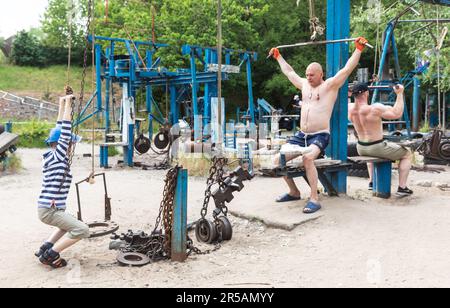Suspension Training System: Using Straps for Full-Body Workouts
Suspension training systems offer a versatile and effective way to engage the entire body in a workout using straps. These systems, often consisting of adjustable straps with handles or loops, leverage body weight and gravity to create resistance. Strength, stability, flexibility, and core engagement can all be greatly enhanced by them.
Suspension training has revolutionized the fitness world, offering a versatile and effective way to engage each muscle group using straps anchored to a specific point. Originating from military training, these systems have become a mainstay in gyms and homes worldwide, allowing individuals to perform countless exercises using their body weight as resistance.
Defining suspension training
Suspension training involves suspending yourself using straps attached to an anchor point, which allows for a wide range of bodyweight exercises. It is a workout that tests your core, strength, stability, and flexibility all at once.
Suspension strap load
These straps usually consist of durable, adjustable nylon material with handles or foot cradles. A variety of models are available, varying in design and features, catering to different fitness levels and workout preferences.
Setting up your suspension training system
Proper setup is crucial for safety and performance. Prior to beginning an exercise, it is crucial to select a strong anchor point, modify the length of the straps, and make sure the handle is positioned correctly.
Full-body workout routine
Suspension straps enable comprehensive workouts. From engaging the core with planks to targeting the upper body with rows and push-ups and working the lower body with lunges, there are countless exercises that can be done.
Benefits of suspension training for fitness
Versatility: These systems allow for different exercises targeting different muscle groups by adjusting body position and angle.
Core Engagement: Almost every exercise involves engaging the core for stability, promoting a strong midsection.
Portability: They are lightweight and portable, enabling workouts anywhere with a sturdy anchor point.
Scalability: Because body position modifies intensity, it is appropriate for all fitness levels.
Core exercise
A. Push-up suspension
Target muscles: chest, shoulders, triceps, and core.
Death Penalty:
Start by adjusting the straps to an appropriate length.
1. Assume a push-up position facing the anchor point holding the handles or loops.
2. Lower your body by bending your elbows while maintaining a straight body line.
3. Take a step back to the beginning position while bracing your triceps and chest.
Tip: Changing the angle by adjusting the straps intensifies or changes the exercise.
B. TRX rows
Target muscles: back, biceps, and core.
Death Penalty:
1. Adjust the straps at waist height.
2. Lean back while maintaining a straight posture by gripping the handles.
3. Keeping your elbows close to your sides, raise yourself up.
4. Lower yourself down with control.
Tip: Change the difficulty by adjusting the angle of your body.
C. Pistol squats
Target muscles: quadriceps, hamstrings, glutes, and balance.
Death Penalty:
1. Hold the handles or loops in front of you.
2. Lift one leg off the ground and extend forward.
3. Slowly lower your body with the supporting leg bent, keeping the other leg extended.
4. Push through the heels to stand back up.
Tip: Use straps for balance assistance as needed.
D. Plank and pike holds
Target muscles: core, shoulders, and stability muscles.
Death Penalty:
1. For planks, set the straps at ankle height and assume a plank position with feet on the handles facing the ground.
2. Maintain a straight body line, engaging core muscles.
3. To hold the pike, start in a plank position, then lift your hips up, forming an inverted V shape.
Tip: Adjust the straps to increase or decrease difficulty.
E. Suspension curl
Target muscles: biceps, arms, and core stability.
Death Penalty:
1. Set the straps at mid-length.
2. Stand facing the anchor point, holding the handles with your palms facing up.
3. Lean back slightly and curl your body towards your hands.
4. Straighten your arms to return to the starting position.
Tip: Keep the core engaged throughout the movement for stability.
Each of these exercises can be modified by adjusting strap length or body position, for a progressive challenge and targeting specific muscle groups. Incorporating them into your suspension training routine can increase strength, stability, and overall fitness.
Tips for beginners
Starting with basic exercises, gradually increasing intensity, and being aware of your limits is important for beginners to avoid overexertion or injury.
Adjust the straps correctly. Make sure they are the correct length for each exercise.
Focus on form: emphasize proper technique over quantity.
Start slowly: Start with basic exercises to build strength and stability.
Use a strong anchor: Check the strength and stability of the anchor before starting.
Suspension training systems offer a dynamic and effective way to achieve a full-body workout. These systems can be an excellent complement to any exercise regimen because of their versatility and capacity to work various muscle groups. They offer a route to strength, stability, and general fitness.
Advanced techniques and workouts
Plyometrics, advanced movements, and increasingly difficult routines can be added to the workout as skill levels rise.
Incorporating suspension training into various fitness regimens
Suspension training can complement other workout styles like yoga, pilates, weight training, and cardio, adding variety and intensity.
Real-life success stories
Many individuals have experienced transformative results with suspension training, demonstrating its effectiveness and versatility.
Maintenance and care of suspension straps
Equipment longevity can be ensured with proper care. Regular cleaning and proper storage methods are key to preserving the straps.
Addressing common misconceptions
Debunking myths and clearing up doubts about suspension training can help dispel misconceptions and encourage more people to try this effective workout method.
Future trends in suspension training
The future holds promising innovations and advancements in suspension training equipment, indicating continued growth in its popularity and adoption.
Suspension training using straps provides an unparalleled full-body workout by providing strength, stability, and flexibility in a compact and versatile package. Adopting this innovative fitness regimen can significantly impact one's overall health and well-being.
FAQs:
1. Is the suspension training system suitable for beginners?
Absolutely! It is ideal for beginners to start with basic exercises and progress gradually.
2. Can suspension training completely replace traditional gym workouts?
While it offers unique benefits, combining it with other workouts can provide a well-rounded fitness routine.
3. Is there an age limit for using the suspension training system?
It is adapted for different age groups, but in specific cases, it is recommended to consult a fitness professional.
4. How often should suspension training workouts be done?
This varies based on fitness goals, but 2-3 sessions per week can be a good start.
5. Can suspension training help you lose weight?
It can aid in weight loss when paired with a balanced diet and regular exercise.


.jpeg)

.jpeg)







